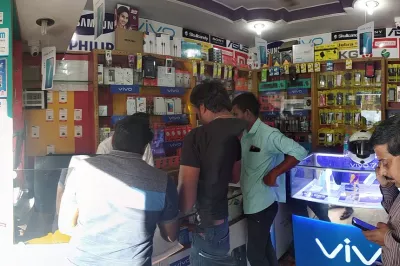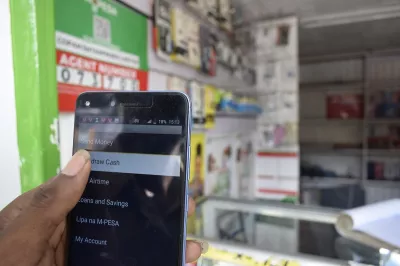Is It Possible to Estimate Financial Stress Before It Harms Borrowers?
Recent research has shown concerning levels of delinquency, default and rollover in digital credit markets. While these studies are useful, they are based on lagging indicators that look backwards and highlight borrower problems that have already been accumulating for some time.
By the time these indicators and studies are produced, significant damage has already been done to consumers, and lenders and supervisors can only take a limited set of reactive, corrective actions to mitigate customer harm and lender or financial sector problems.
Collecting and monitoring lead indicators that estimate financial stress before borrowers, lenders and the overall financial sector are harmed would make it possible to take more pre-emptive action. Little research has been done to develop tools to track such indicators, but a financial stress early warning system that CGAP is piloting with digital lender 4G Capital is showing early signs of success.
What is a financial stress early warning system?

The initial concept for a financial stress early warning system was inspired by the famine early warning systems that have helped countries around the world to identify food insecurity risks months or years before a crisis hits and avert famine. The idea was to build a system that would similarly enable lenders and supervisors to monitor a small number of lead indicators of financial stress at low cost for all customers or a sample of them, helping lenders to avert repayment problems within their portfolios and supervisors to preempt market-level issues.
To test the idea out in the real world, CGAP partnered with 4G Capital, a Kenya-based digital lender targeting micro and small entrepreneurs. Together, over the past 9 months we have been developing and testing a customer financial stress early warning system in Kenya.
The system we are piloting identifies customer financial stress levels based on the coping strategies they adopt. People change their spending and consumption patterns in the face of financial challenges. These coping strategies may be mild, such as switching to lower-cost foods or brands or reducing spending on entertainment. Or they may be severe, such as pulling children out of school, skipping meals, or worse. The presence of these coping strategies indicates current levels of stress, and by tracking these indicators over time, we will be able to monitor whether stress levels are rising. Our hypothesis is that stress levels correlate with behaviors such as delinquency or default. The next step will be to confirm whether stress levels can estimate customer repayment behavior and be used to minimize or prevent over-indebtedness.
We are testing three ways of collecting data on coping strategies: SMS surveys, call center surveys, and in-person visits linked to existing staff visits to borrowers to provide business training seven days after loan disbursal.
What is the pilot data telling us about financial stress among digital borrowers?
Despite the daily economic challenges experienced by micro-enterprises operating in the informal economy, 4G Capital’s customer base typically has a high repayment rate without the need for refinancing. The company attributes this to its model that blends business training, right-sized working capital credit, and human and technology “touch-tech” customer liaison channels.
Nevertheless, an SMS survey of 692 4G Capital customers in June 2021 showed that 83 percent of customers were experiencing some degree of financial stress. They were evenly distributed among:
- High financial stress (e.g., selling assets to meet basic needs)
- Moderate stress (e.g., reducing food expenditures)
- Mild stress (e.g., reducing basic household expenditures)
About 75% of 4G Capital customers are women. The SMS survey data disaggregated by gender reveals that the rates of financial stress did not vary between women and men (although women did report a greater incidence of shocks and stressors, and on average they had lower income levels).
This data suggests that even though customers were making timely repayments on their digital loans, many were experiencing significant personal challenges and faced tough financial decisions. Some sacrificed basic needs to maintain their businesses and credit rating. In one of the more extreme examples, a customer reported that she has used up her savings to pay bills and support her daughter, who lost her job. She indicated that she had sold her refrigerator and gas stove to pay rent and that she was using charcoal to cook.
It is worth noting that the financial stress revealed for 4G Capital’s customers may be different compared to other lenders. 4G Capital focuses on productive lending to increase a microenterprise’s revenue and profitability, so they need to check in detail that their customers have a viable business that will generate enough profits to repay their loans. Other lenders that offer digital consumer credit via mobile apps, using algorithms to assess a customer’s likelihood of repayment, may have different types of customers who could potentially experience far greater levels of financial stress.
How can this early warning system be used?
The purpose of the early warning system is not to define acceptable levels of financial stress or eliminate its causes. Rather, it is to equip lenders and supervisors with a tool to assess and better manage the effects of stress as part of broader risk management processes. While the indicators used to test this tool are specific to Kenya, there is sufficient data on financial stress and coping strategies across most countries to allow for the development of similar early warning tools for other markets, following the process developed during this pilot. At the firm level, lenders can use better data about the actual levels of stress and how they relate to future customer performance to improve their risk management and lending decisions.
At the market level, supervisors, industry associations and funders can use the data to measure and monitor indicators of customer financial stress and assess how lenders are managing them. COVID-19 has underscored the importance of having an early, data-driven understanding of financial stress among low-income and vulnerable borrowers before it leads to consumer harm.
What are the next steps to develop the system?
Through our pilot with 4G Capital, we have developed and tested a tool based on a simple set of rigorously tested coping strategy indicators. Statistical analysis has demonstrated that the system consistently measures financial stress and allows 4G Capital to estimate current stress levels within its client portfolio.
The next step will be to test the extent to which existing stress levels predict future customer behavior and serve as an early warning system for problems such as delinquency, default and rollover. The vast majority of 4G Capital’s clients opt for a 30-day loan term, meaning that this predictive analysis will be possible in the coming weeks. We will share the predictive results in a follow-up blog post.
For a more detailed explanation of the early warning system methodology and the tool development and testing process, stay tuned for our next blog. This pilot is part of CGAP’s broader efforts to foster the use of market monitoring tools to identify, assess and track digital financial consumer risks and outcomes.




Comments
I also think it advisable…
I also think it advisable for market conduct regulators to develop their own measurements and indicators for consumer and household over indebtedness and monitor same. Then, when financial institutions are deemed to be contributing abnormally to consumer over indebtedness, they can be sanctioned accordingly (e.g. paying into a collective consumer protection fund based on the previous year's NPLs). I think it is also important to note that consumers who are over indebted frequently default on loans which can result in very negative and life altering consequences for them; ranging from negative credit listings which impede employment or future borrowing to loss of assets used as collateral and even to incarceration in prisons for periods of six months or longer. In quite a few developing countries, colonial era legislation allowing for creditors to incarcerate borrowers who default remains the law of the land (e.g. Uganda & Tanzania). In other countries, abusive debt collection practices include creditors making allegations of fraud and 'wrongful conversion' of funds in order to use the courts and the threat of incarceration to debt collect from the poor (e.g. Sierra Leone, Egypt and Jordan). Therefore, it would also be advisable for financial inclusion stakeholders to evaluate the legal frameworks, and consider how to best provide concrete solutions for debt relief to over indebted consumers. Insolvency/bankruptcy proceedings are generally NOT available to consumers as individuals in developing countries. This means that they are beholden to their creditors for life+ when unable to repay a debt, unlike in developed economies where debt relief in some form or other is an available remedy by law to consumers as well as corporations. If there are debt relief solutions in place for consumers, lenders will be more concerned about their credit risk analysis procedures and as a result, less over indebtedness.
Add new comment